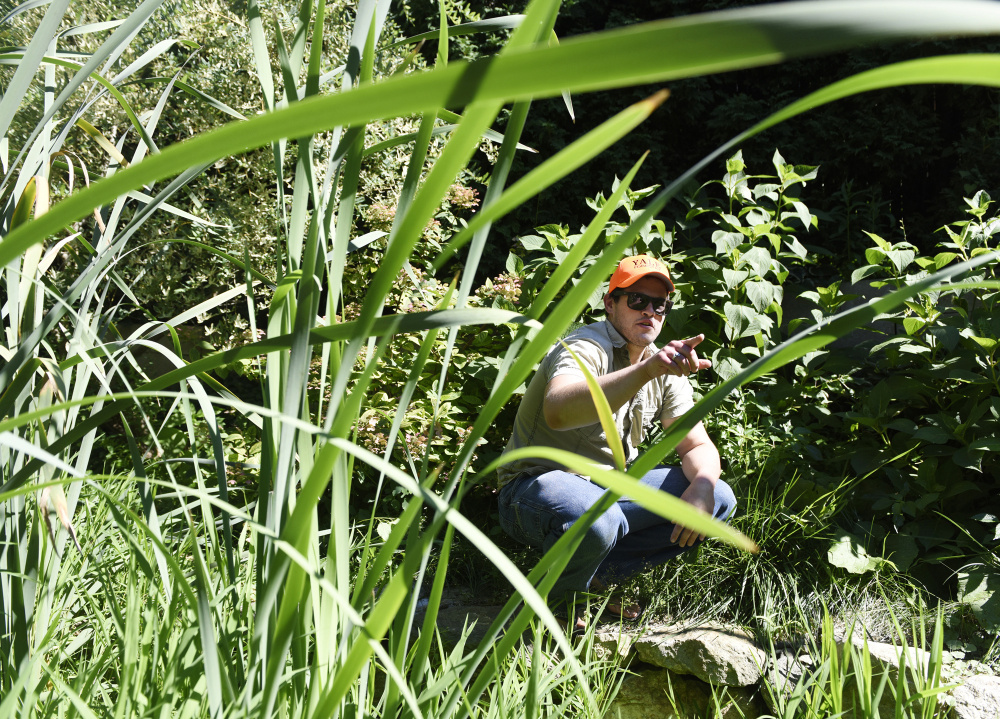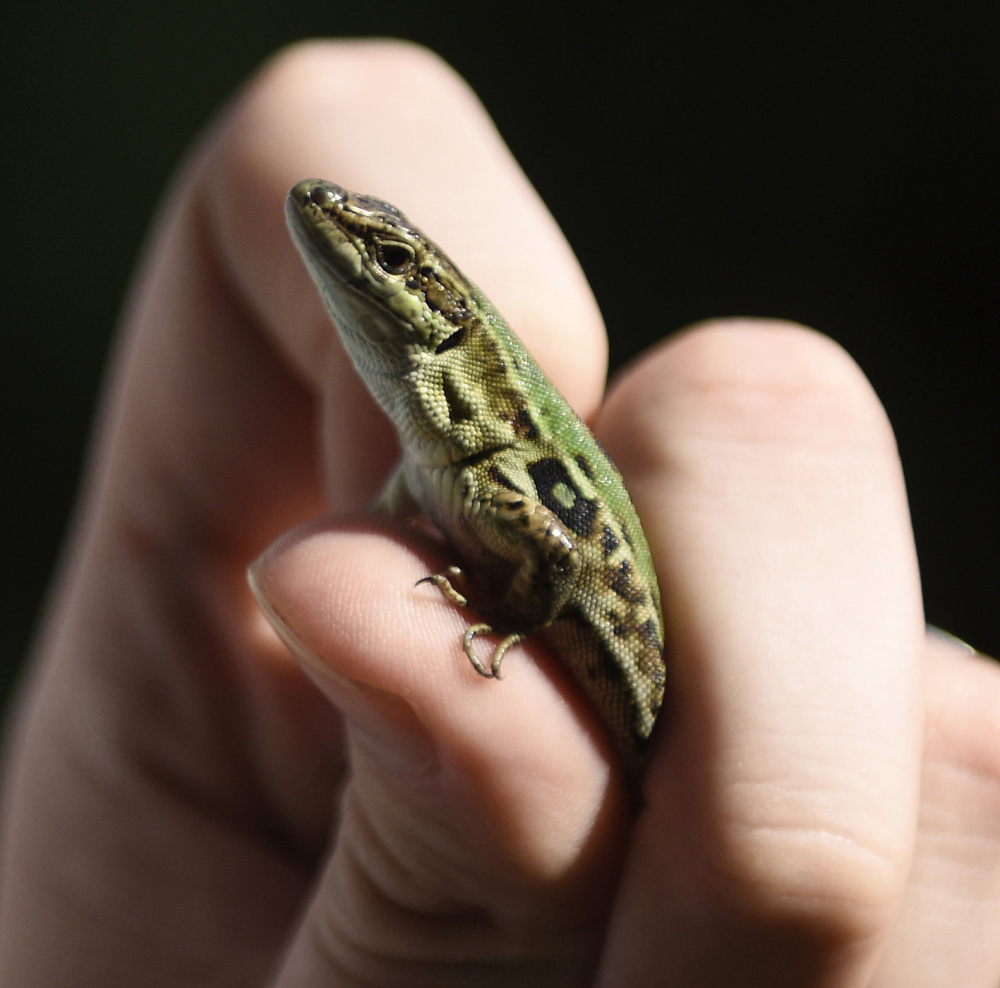GREENWICH, Conn. — On a sunny afternoon this week Max Lambert stood in a backyard abutting the Cos Cob train tracks. In his hand, thrashing to and fro, was a writhing mass of nerves, encased in dark, scaly skin.
Lizard skin.
“I missed him, I got his tail tip,” said Lambert, a Ph.D. candidate at Yale. “It’s a predator defense; it’ll grow right back.”
The tail belonged to an Italian wall lizard, which can move uncannily quickly – in more ways than one. The reptiles can easily outpace an Ivy League academic, and over the course of only a few generations appear able to adapt to new environments – faster than most other members of the animal kingdom.
ALL ABOARD FOR GREENWICH
Which has brought Lambert and colleagues to Greenwich – specifically to properties in town along the Metro-North train line. The scientists believe the lizards are using the corridor as a route north to a climate that is significantly colder than those other populations typically occupy in Europe or North America.
“It’s great habitat, and it’s a really nice expressway for them to travel distances,” said Colin Donihue, a post-doctoral researcher at Harvard, who is leading the Metro-North lizard study. Donihue has been charting the movement and transformation of a lizard population in Greece for years.
“In some areas (of the train line), there are heated portions of the tracks so they don’t freeze, especially when tracks are changing at forks and that sort of thing,” he said.
The lizards are small, most about 4 inches long, and blend in with the mottled gray stones that the tracks rest on. They have long, narrow mouths with serrated teeth that they use to eat insects.
The origin of the migrating population in Greenwich is not known for certain. There are several populations in New York City and Long Island they could have come from. The researchers said they hope skin samples they take from captured lizards will help them determine their origin.
One possibility is the reptiles escaped from a damaged pet container in West Hempstead on Long Island. Another is they came from a pet store in the Bronx that sold them in the 1960s. It’s possible some escaped and started a wild breeding population. Donihue said he even heard a rumor that a pet truck crashed in the Bronx and the lizards escaped in the ensuing mayhem, though he hasn’t been able to confirm the story.
What he does know is that once the lizards escaped they had little trouble forging a new home in New York City, and have been spotted farther and farther north as time has gone on.
The farthest from the city Donihue and his team have found a lizard is a mile south of the Cos Cob train station. They have looked but haven’t yet found any lizards in Stamford.
A BRIDGE TOO FAR
Donihue thinks a barrier preventing the animals from traveling on is Cos Cob Harbor. When northbound trains rumble out of the Cos Cob train station, they quickly cross a bridge over the harbor, a desert without refuge or food for the lizards.
Donihue has seen some backyards with as many as 15 to 20 lizards, which leads him to suspect the Greenwich population is in the hundreds, but somewhere shy of 1,000. He first needs to figure out how far from the tracks they have strayed to determine a more accurate population estimate.
The scientists are interested in not just how the lizards are moving north, but why. Donihue’s research focuses on the ways animals adapt to habitats altered by humans, a setting readily found in Fairfield County.
“It would feed into this bigger question of what makes an invasive species successful, and how can we understand how those species are evolving to live side-by-side with humans,” he said.
He believes the Greenwich lizards’ metabolisms are slowing down and becoming better regulated than their relatives in Greece and Italy to adjust to the cold, but he doesn’t think that’s the only thing allowing them to move this far.
“We’re starting to talk about animal personalities, so maybe these lizards right at the invasion front are more risk-taking or interested in trying out new types of food or exploring different areas,” Donihue said.
While non-native, the lizards pose little problem, he said, and fit smoothly into a niche of the suburban ecosystem: They eat bugs, and are eaten by cats.
“They’re invasive in the sense that they are breeding and spreading, but my sense so far is that they don’t pose a threat to native species in the same way that we hear about the really bad invasives like the zebra mussel,” Donihue said. “They are essentially moving into territory where there aren’t any other lizards to compete with.”
SKINKS HAVE COMPANY
The only other lizards native to Connecticut are skinks, and they aren’t found in the same habitats these lizards are occupying.
In the summer, the Italian wall lizards spread out into gardens, lawns and hedges to catch bugs, but in the winter the lizards likely rely on heat sources such as warm laundry ducts and compost piles rotting from the inside out to make it, Donihue said.
They are known for being mildly aggressive toward each other, Lambert said, and being forced to bunker into close quarters for long months at a time might provide the most severe control on their population.
Catching the lizards is only the first part of the researchers’ quest to learn more about them. With the ones they caught in Greenwich this week, Donihue can add data points to guide his estimates of how far they have traveled, but lab tests done on the captured lizards will reveal more about their ancestry and how they are managing in the new challenging environment.
Like most research projects, the speed and success of this one will depend on funding. Both Donihue and Lambert have previously used crowd funding to sustain their research, but they said it is a path they would rather avoid because it is unpredictable and time consuming. They are hoping a major donor might come through.
The scientists recently lassoed three lizards in one Cos Cob yard and another on a plot closer to the train station. Unlike some other animal migrations that have been observed around the globe in recent years, Donihue doesn’t believe this migration is being driven by climate change, but instead by unintentional micro-climates created by human land use and development.
“For these kinds of lizard those year-to-year fluctuations that we’re seeing with climate change are actually just as likely to knock back the invasion front as they are to help it run forward,” Donihue said. “I think the human land use is the stronger driver for these lizards. We’re certainly seeing range expansions for lots of species over large geographical swathes, but I don’t think that’s what’s happening here.”
Send questions/comments to the editors.




Success. Please wait for the page to reload. If the page does not reload within 5 seconds, please refresh the page.
Enter your email and password to access comments.
Hi, to comment on stories you must . This profile is in addition to your subscription and website login.
Already have a commenting profile? .
Invalid username/password.
Please check your email to confirm and complete your registration.
Only subscribers are eligible to post comments. Please subscribe or login first for digital access. Here’s why.
Use the form below to reset your password. When you've submitted your account email, we will send an email with a reset code.